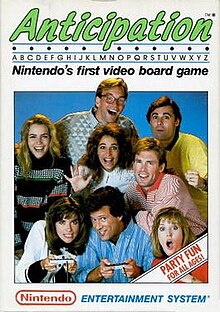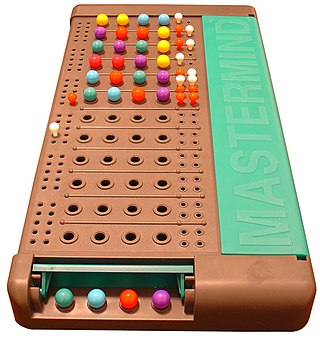
Mastermind or Master Mind is a code-breaking game for two players invented in Israel. It resembles an earlier pencil and paper game called Bulls and Cows that may date back a century.

Nonograms, also known as Hanjie, Paint by Numbers, Picross, Griddlers, and Pic-a-Pix are picture logic puzzles in which cells in a grid must be colored or left blank according to numbers at the edges of the grid to reveal a hidden picture. In this puzzle, the numbers are a form of discrete tomography that measures how many unbroken lines of filled-in squares there are in any given row or column. For example, a clue of "4 8 3" would mean there are sets of four, eight, and three filled squares, in that order, with at least one blank square between successive sets.

R.O.B. is a toy robot accessory for the Nintendo Entertainment System (NES). It was launched in July 1985 as the Family Computer Robot in Japan, and October 1985 as R.O.B. in North America. Its short lifespan yielded only two games in the Robot Series: Gyromite and Stack-Up.

The Super Game Boy is a peripheral that allows Game Boy cartridges to be played on a Super Nintendo Entertainment System console. Released in June 1994, it retailed for $59.99 in the United States and £49.99 in the United Kingdom. In South Korea, it is called the Super Mini Comboy and was distributed by Hyundai Electronics. A revised model, the Super Game Boy 2, was released in Japan in January 1998.
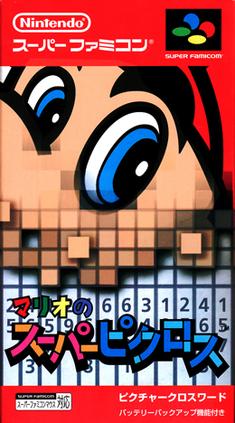
Mario's Super Picross is a Super Famicom sequel to Mario's Picross. The game is compatible with the Super Famicom Mouse. It is developed by Jupiter Corporation and Ape and published by Nintendo.
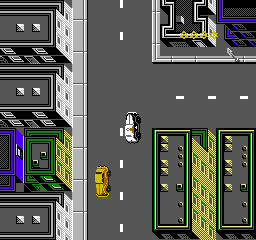
Dick Tracy appeared in the following video game tie-ins for the motion picture:
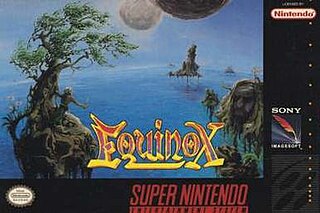
Equinox is an action adventure puzzle video game developed by Software Creations and published by Sony Imagesoft for the Super NES. A sequel to Solstice (1990) for the Nintendo Entertainment System, Equinox depicts Glendaal saving his father Shadax, the previous game's playable character, from the imprisonment of Sonia, Shadax's apprentice. The player acts as Glendaal, exploring 458 rooms in eight underground dungeons. The player collects 12 blue orb tokens while solving puzzles, killing enemies, collecting keys, navigating platforms and blocks, and battling bosses. It continues Solstice's isometric puzzle game style, with greater emphasis on action adventure and Mode 7 overworld map.

Pictionary, taglined The Game of Video Quick Draw, is a video board game developed by Software Creations and published by LJN for the Nintendo Entertainment System. It is based on the board game of the same name. Players may play in up to four teams of unlimited players.
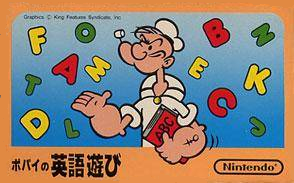
Popeye no Eigo Asobi is a 1983 edutainment platform video game developed and published by Nintendo for the Family Computer. The game was based on the comic strip of same name created by E. C. Segar and licensed from King Features Entertainment. It is a spin-off of the Popeye arcade game made by Nintendo. It was released exclusively in Japan. It was followed by the similar Donkey Kong Jr. Math, which was released about one month later. This game was never released in North America because of the majority of English speakers in the United States and Canada and a corresponding version that would teach players Japanese was not created due to the technical limitations of the Nintendo Entertainment System along with the lack of popularity in the West to learn Japanese aside from cultural or business purposes in the 1980s.

Magical Tetris Challenge is a puzzle game by Capcom for the Nintendo 64, Game Boy Color, and PlayStation. It is a version of Tetris featuring Disney characters. It is one of the few Nintendo 64 games to be entirely in 2D, in addition to being Capcom's first game for the console.

Mickey's Ultimate Challenge is a puzzle video game developed by Designer Software and co-published by Walt Disney Computer Software and Hi Tech Expressions for the Super NES, Game Boy, Genesis/Mega Drive, Master System, and Game Gear. The Master System version, released in Brazil by Tectoy in 1998, was the last game released for that console. All other versions were released in 1994. Players move Mickey through the game by making him walk, jump, and go through doors. There are five major challenges, a segue, and a final challenge. It was met with mixed reviews from gaming magazines.

The Brainies is a puzzle game released on the Super Nintendo Entertainment System console and Atari ST, Amiga, Apple IIgs, Macintosh, and Amstrad CPC computers. Even though its European title is Tiny Skweeks, the connection to the popular Skweek series was made late. The game is also known as The Tinies on home computers.
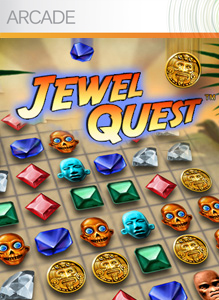
Jewel Quest is a tile-matching puzzle video game created and published by iWin. First released for Windows, it has been redeveloped for Symbian S60, the Nintendo DS, the Xbox 360's Xbox Live Arcade and other platforms. iWin also released a series of sequels and spin-off games.

Pandora's Box is a 1999 video game created by Alexey Pajitnov for Microsoft.
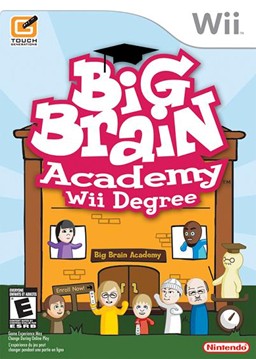
Big Brain Academy: Wii Degree, known in PAL regions as Big Brain Academy for Wii, is a video game released for the Wii. A sequel to the game Big Brain Academy for the Nintendo DS, it too measures a player's brain's weight, but with new games and puzzles to solve. The game makes use of Miis and uses WiiConnect24 features, allowing competition amongst users' friends, whose codes are automatically imported from the Wii's internal address book.

Picross DS (ピクロスDS) is a puzzle video game developed by Jupiter Corporation and published by Nintendo for the Nintendo DS handheld video game console. It is the second Picross game to be released by Nintendo in Europe and North America after Mario's Picross suffered a commercial failure in regions outside Japan, where many Picross games have been released for several Nintendo consoles. Like other Picross games, it presents the player with a series of nonogram logic puzzles to solve. It was first released in Japan, and was later released in North America, Europe and Australia.

Pieces is a 1994 puzzle game for the Super NES. It was developed by Prism Kikaku and published by Hori Electric in Japan and by Atlus Software in North America. In the game, the player has to solve jigsaw puzzles. In 2002, the spiritual successor developed by the same company, Jigsaw Madness, was released for the PlayStation.
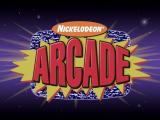
Nick Arcade is an American children's game show created by James Bethea and Karim Miteff and hosted by Phil Moore, with Andrea Lively announcing, that aired on Nickelodeon in 1992. It aired originally during weekend afternoons, with reruns airing until September 28, 1997. In the first season, the shows were taped in December 1991 and aired in early 1992. It was taped at Nickelodeon Studios at Universal Studios Florida in Orlando. In Nick Arcade, two teams of contestants played two initial trivia rounds, with the winning team advancing to the "Video Zone" to play against the virtual "Video Game Wizard" of the day.
There have been a variety of Sesame Street video games released for video game platforms. Most of the Sesame Street video games were published and developed by NewKidCo.

Rubik's Puzzle World, known as Rubik's World in North America, is a puzzle video game for the Wii and Nintendo DS platforms developed by Two Tribes and published by The Game Factory. The video game features the famous Rubik's Cube, originally designed by the Hungarian inventor Ernő Rubik. The game contains the likeness of the cube as well as a playable version of the Rubik's Cube, as well as multiple puzzle game modes involving the Cube's constituent parts, known as "Cubies".
